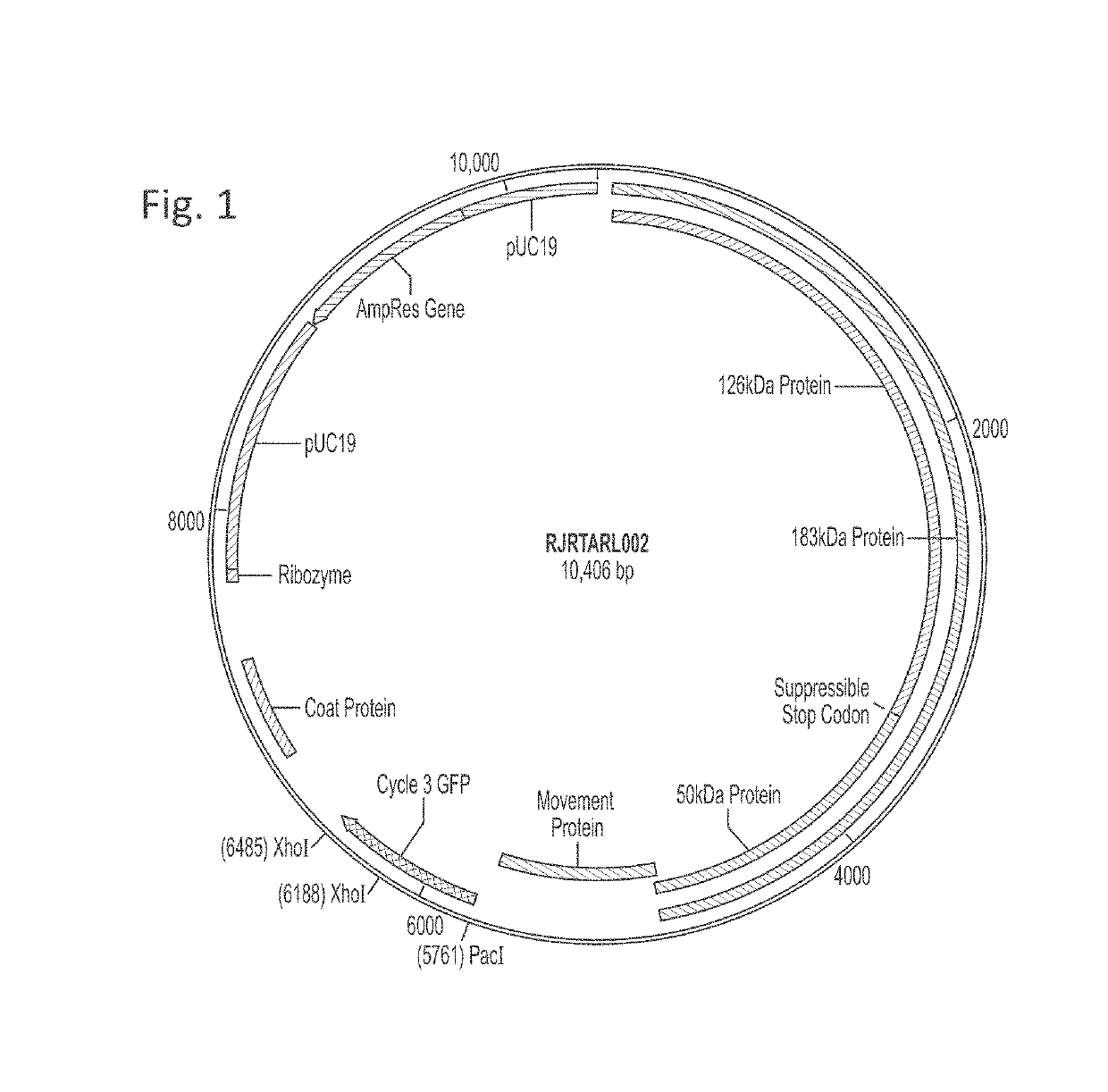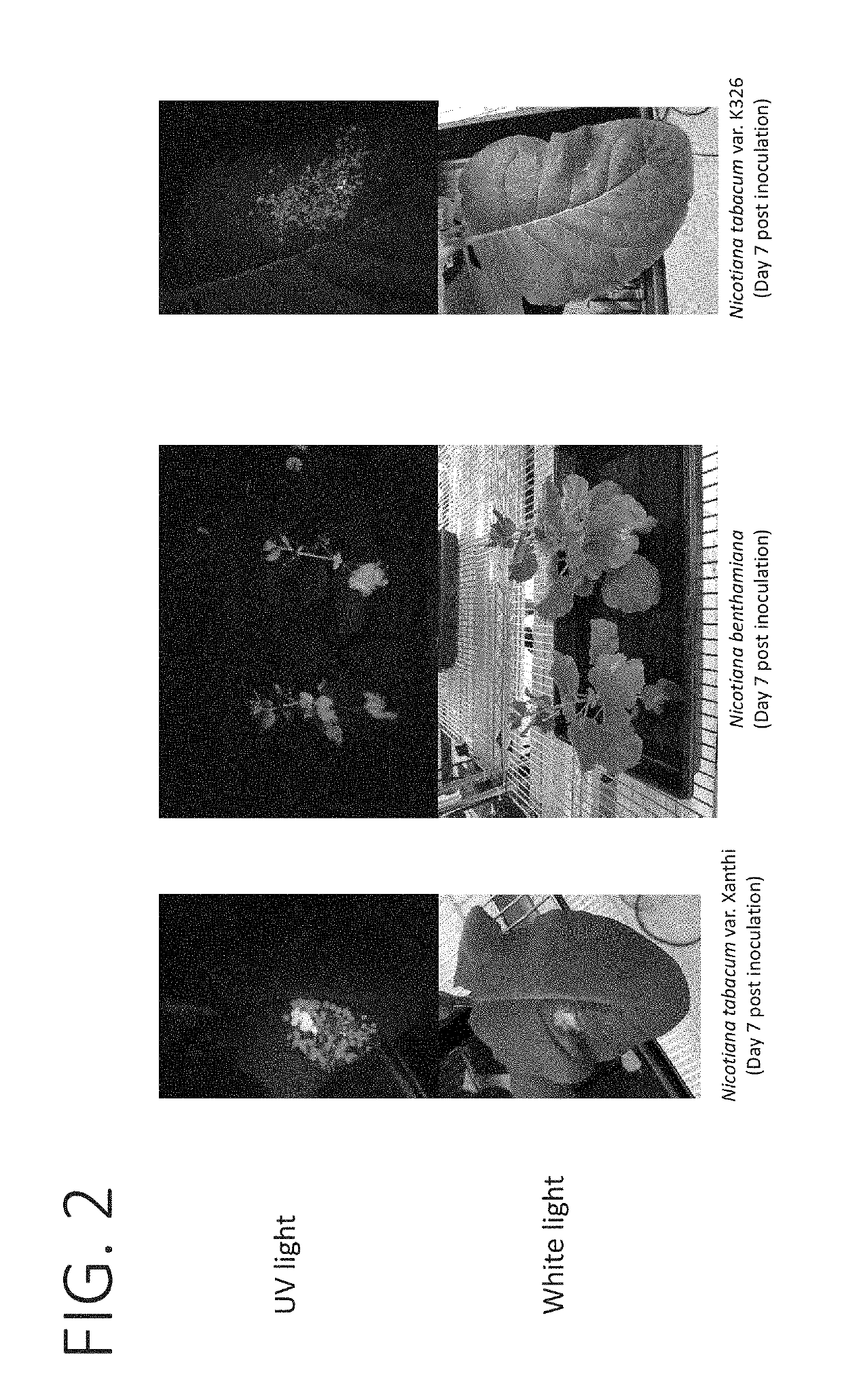Methods and compositions for viral-based gene editing in plants
- Summary
- Abstract
- Description
- Claims
- Application Information
AI Technical Summary
Benefits of technology
Problems solved by technology
Method used
Image
Examples
example 1
Mediated Transformation System
[0149]Vector construction: A GENEWARE® TMV vector (such as pDN15) is preceded by a T7 RNA polymerase promoter operatively linked to the tobamovirus vector genome such that the first transcribed nucleotide promotes capping through in vitro transcription and correct initiation with the virus genome sequence. The vector (such as pDN15) is modified with an insertion downstream of the native coat protein subgenomic promoter comprising of a reporter gene, such as the green fluorescent protein (GFP), basta resistance (bar), or fusion of the two genes to produce a bi-functional protein. A second insertion is made downstream of the reporter construct, including a second coat protein subgenomic promoter from a different tobamovirus genome followed by the gene editing endonuclease (including one of the following TALEN, ZFN, CRISPR-cas9, or a meganuclease). The vector (such as pDN15) lacks the coat protein to insure lack of systemic and persistent infection and ter...
example 2
ing Procedure
[0150]Infectious vector RNA is synthesized in vitro with T7 promoter. Synthesized RNA is delivered into plant leaf cells by direct mechanical transmission using rubbing, high pressure spray, gene gun or similar technologies. The synthesized RNA serves as the shuttle containing the endonuclease RNA sequence. Virus transcripts are translated in infected plant cells producing replication proteins to multiple genomic RNAs and produce subgenomic RNA sequences. The RNA undergoes replication to produce subgenomic RNAs including reporter gene and endonuclease encoding RNAs. These are translated to provide reporter for infection (visual or through herbicide selection) and the endonuclease protein, which edits the plant genome in a site specific manner.
[0151]Leaf materials can be used for selection of infection sites in situ or through cell culture. For in situ selection, basta is sprayed on leaf surface, infected leaf tissues where virus vector RNA containing the basta resistanc...
example 3
n of a GENEWARE® Vectors and Expression of a GFP Reporter Protein in Transformed Plant Cells
[0152]A. Generation of a GENEWARE® Recombinant Vector with GFP
[0153]In these experiments, the GENEWARE® vector derived from Tobacco Mosaic Virus (TMV) was used. Using the GENEWARE® vector, a gene encoding foreign protein can be inserted in place of the virus coat protein (CP), so it will be driven by the endogenous virus CP promoter and overexpressed in plant cells (Pogue et al., 2010).
[0154]To confirm that a Geneware® vector can infect tobacco plants and produce foreign protein in tobacco cells (Pogue et al., 2010), the RJRTARL002 vector was constructed essentially as described in Example 1. FIG. 1 shows a map the RJRTARL002 vector comprising the GENEWARE® vector modified to express the cycle 3 green fluorescent protein (c3GFP). RJRTARL002 is the GENEWARE® vector having the cycle 3 Green Fluorescent Protein (c3GFP) inserted between the sequences coding for the coat protein and the movement p...
PUM
| Property | Measurement | Unit |
|---|---|---|
| molecular weight | aaaaa | aaaaa |
| length | aaaaa | aaaaa |
| diameter | aaaaa | aaaaa |
Abstract
Description
Claims
Application Information
 Login to View More
Login to View More - R&D
- Intellectual Property
- Life Sciences
- Materials
- Tech Scout
- Unparalleled Data Quality
- Higher Quality Content
- 60% Fewer Hallucinations
Browse by: Latest US Patents, China's latest patents, Technical Efficacy Thesaurus, Application Domain, Technology Topic, Popular Technical Reports.
© 2025 PatSnap. All rights reserved.Legal|Privacy policy|Modern Slavery Act Transparency Statement|Sitemap|About US| Contact US: help@patsnap.com


